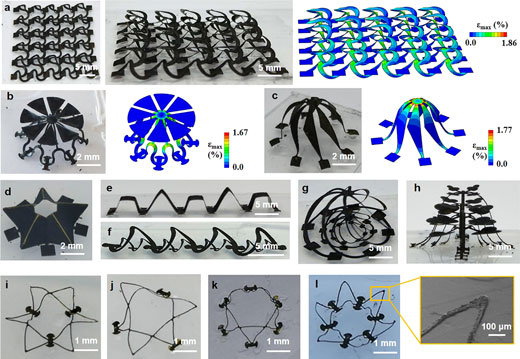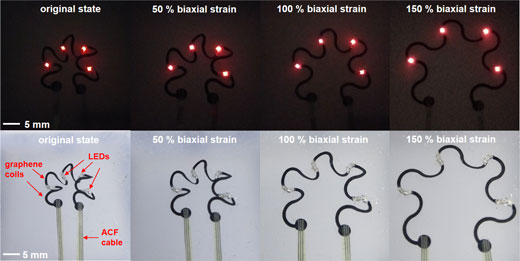| Nov 20, 2018 | |
Mechanically assembling 3D cellular graphene structures(Nanowerk News) The assembly of graphene and other emerging two-dimensional (2D) materials into cellular structures can avoid intersheet restack and retain their outstanding intrinsic properties, thereby enabling broad applications in energy storage, catalysis, polymer composites, electromagnetic shielding, and many others. |
|
| Also, the applications of cellular graphene in emerging wearable devices have attracted rapidly growing interests, because of their high electrical conductivities, large surface areas, and fully interconnected porous geometries. | |
| A number of techniques have been recently developed to fabricate cellular graphene with engineered architectures, such as hydrothermally induced self-assembly, chemical vapor deposition, 3D printing, and transient laser heating. | |
| However, the current fabrication strategies of cellular graphene are only able to realize limited structure control and are hard to achieve the construction of 3D hierarchical architectures with complex, programmed configurations, limiting the design capabilities to satisfy various next-generation device applications. | |
| Researchers now have reported in ACS Nano ("Mechanically Assembled, Three-Dimensional Hierarchical Structures of Cellular Graphene with Programmed Geometries and Outstanding Electromechanical Properties") that they have achieved the design and implementation of 3D hierarchical architectures of cellular graphene with programmed geometries and outstanding electromechanical properties through the use of mechanically guided, 3D assembly. | |
 |
|
| Mechanically guided, 3D hierarchical structures of cellular graphene with various geometries. (a) Top view (left) and side view (middle and right) of a 5 × 6 array of double-floor helices. Kirigami-inspired, jellyfish-like (b) and windmill-like (c) structures. Origami-inspired, five-pointed-star-like (d) and alternative mountain-like (e) structures. 3D structures with fully separated multilayers: double-layer helical coils (f), trilayer cages (g), and four-layer trees (h). (i-l) 3D open-mesh structures interwoven with fine ribbons (∼30 µm in width). In a-c, the color in the FEA results corresponds to the magnitude of the maximum principal strain in the cellular graphene. (Reprinted with permission by American Chemical Society) (click on image to enlarge) | |
| A research team from University of Missouri, Tsinghua University, and Xi’an Jiaotong University used CO2 laser-induced cellular graphene as the model material to illustrate the 3D assembly process. They adopted finite element analysis (FEA) to design the 2D patterns and predict 3D geometries. | |
| In this work, the team experimentally fabricated more than 10 3D hierarchical architectures of laser-induced cellular graphene, indicating the capability of building 3D hierarchical structures with broad geometries. | |
| Furthermore, these structures geometrically match well with the FEA predications, validating the basic ideas of computational modeling as a design tool. | |
| The device examples include LED arrays interconnected with 3D helical coils and 3D interdigital supercapacitors fabricated with solid-state electrolytes, exhibiting outstanding electromechanical properties. | |
| For example, the LED arrays remain functional even after 1000 cycles of biaxial stretching to 100%. The change of the areal capacitance of 3D supercapacitors is negligible when the device is biaxially stretched to 100%. Furthermore, after 100% cyclic stretching for 1000 times, the areal capacitance only changed ∼9%. | |
 |
|
| Highly stretchable LED arrays interconnected with 3D helical coils of cellular graphene. The optical images on the top were taken in the dark and illustrate the LED array during operation under different biaxial strains. The optical images on the bottom demonstrate their related configurations under stretching. (Reprinted with permission by American Chemical Society) | |
| Bending and stretching under both static and cyclic loading conditions were shown to have trivial effects on the device performances, indicating their potentials for next-generation wearable electronics and energy devices. | |
| Furthermore, the fabrication approach reported here is versatile and scalable and can be extended to the design and implementation of 3D hierarchical structures and devices of cellular graphene and other 2D materials with porous geometries for different applications. |
 By
Michael
Berger
– Michael is author of three books by the Royal Society of Chemistry:
Nano-Society: Pushing the Boundaries of Technology,
Nanotechnology: The Future is Tiny, and
Nanoengineering: The Skills and Tools Making Technology Invisible
Copyright ©
Nanowerk LLC
By
Michael
Berger
– Michael is author of three books by the Royal Society of Chemistry:
Nano-Society: Pushing the Boundaries of Technology,
Nanotechnology: The Future is Tiny, and
Nanoengineering: The Skills and Tools Making Technology Invisible
Copyright ©
Nanowerk LLC
|
|
|
Subscribe to a free copy of one of our daily Nanowerk Newsletter Email Digests with a compilation of all of the day's news. |
